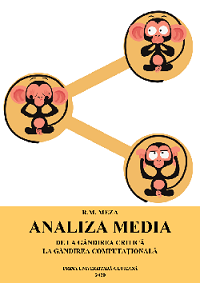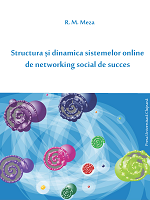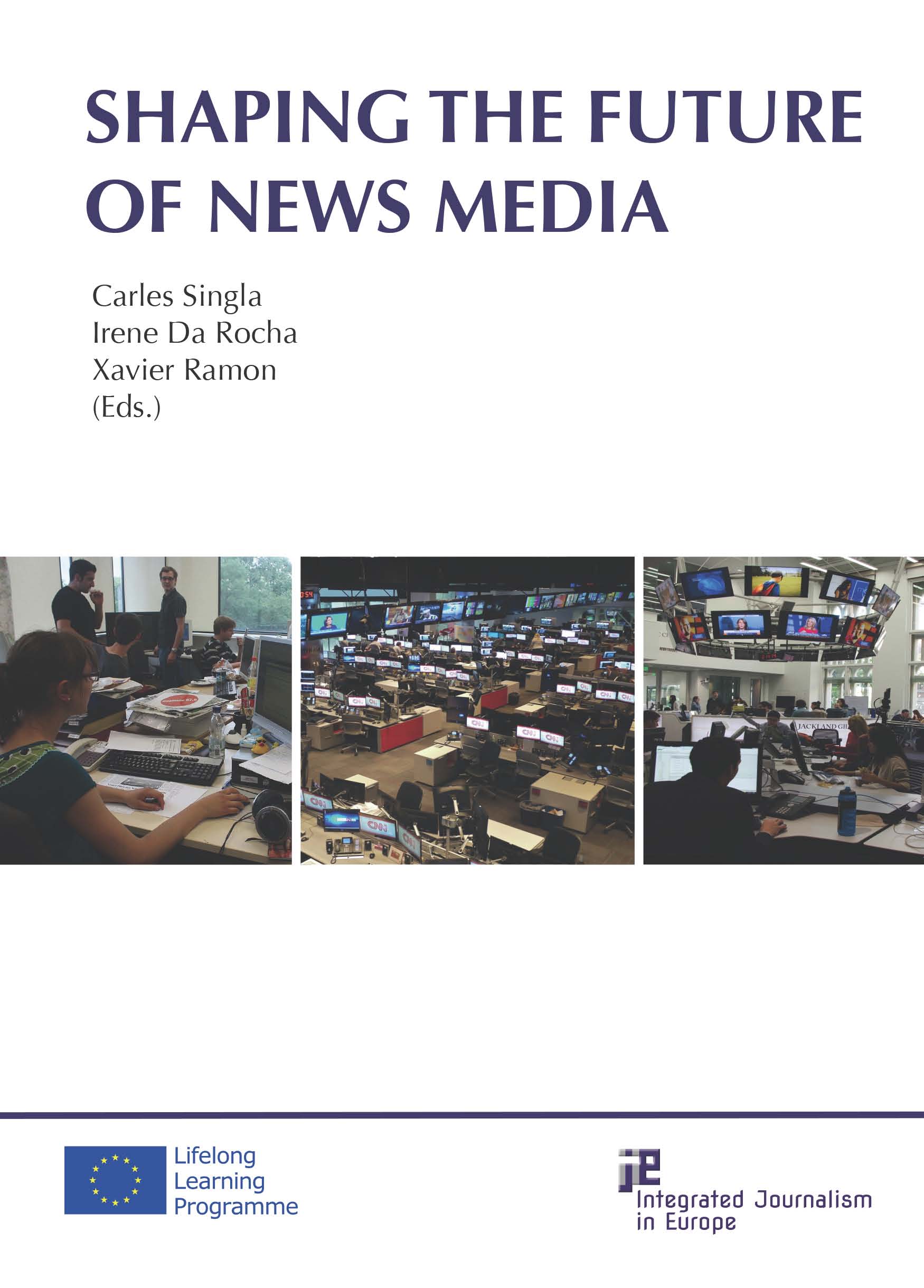Selected Publications
My list of selected publications includes conference proceedings, journal articles, book sections and book chapters, co-edited books and authored books. Due to the interdisciplinary nature of my education and research interests, some publications fall under Computer Science and Engineering, while other under Social Sciences and Humanities.
Filter by type:
Sort by year:
Rhetorics of Hope and Outrage: Emotion and Cynicism in the Coverage the Schengen Accession
Journal PaperMedia and Communication, vol 11, no 4, 2023, 47-61
Abstract
Discourses on European integration and Euroscepticism have benefitted from increased interest after Brexit. Researchers point out that there is a great variance from one national context to another and that there is a gap in the literature concerning non-elite discourses and perspectives from Central and Eastern European countries such as Romania. The Eurobarometer findings of early 2023 indicate a shift in Romanian public opinion towards Euroscepticism. To better understand the potential causes for these shifts, we approach the politicisation of the issue in Romania through an analysis of online news headlines and related social media news sharing metadata. In the aftermath of the decision not to accept Romania and Bulgaria, this research investigates shifts in the media framing of the Schengen issue and EU over two months (from October 15 to December 15, 2022) in the 14 most accessed Romanian online news sites (with more than 10 million visits per month). Quantitative analysis of news headlines (N = 3,362) shows that the coverage focuses on Romanian politicians in power and emphasises conflict. Furthermore, the analysis of the interactions produced by news sharing of the analysed sample shows the impact of the political rhetoric encouraging the boycotting of Austrian companies in retaliation for the denial of Schengen Area accession: scapegoating and disenchantment with politics and politicians. The two-step approach used and results that use Facebook interactions as indicators of public resonance of politicisation and strategic framing may be replicated in future research.
Idols of Promotion and Authenticity on TikTok
Journal PaperMedia and Communication, vol. 11, no. 4, 2023, 187–202
Abstract
TikTok’s rapid growth in the past few years, especially in the younger demographic, may signal a market shift. With children, teens, and young adults reportedly making up 40% to 60% of its user base, the platform is becoming the strongest challenger to YouTube, Facebook, and Instagram. The most followed TikTok celebrities are mostly young people who have either grown up with the platform or recently extended their popularity from other platforms to reach new audiences. This research investigates the discursive strategies and persona performances employed by the top 25 TikTok celebrities under the age of 25 in both popular content and content marked as advertising. A large sample of TikTok content metadata was collected using API interrogation. From each of the 25 young TikTok celebrities, up to 1,000 videos per user (N = 22,650) are explored using quantitative approaches. Two subsamples are analysed using visual, rhetorical, and narrative analysis to evaluate the most popular content (Np = 226) and content marked as advertising using the TikTok ad flagging (Na = 213). The findings include the identification of seven persona performance types and a significant difference in terms of performed ordinariness in content marked as advertising.
Analiza media. De la gândirea critică la gândirea computațională
Book Presa Universitară Clujeană | 2020 | ISBN:978-606-37-0772-8

Această carte încearcă să prezinte analiza media ca o preocupare multi-disciplinară, ce utilizează noțiuni din retorică, studiile culturale și media, lingvistică, științe sociale și ale comunicării, dar și din informatică. Calități precum obișnuința de a a pune la îndoială reprezentările și practicile media și capacitatea de a deconstrui structurile narative și de semnificare sau chiar de a detecta șabloane discursive în cantități mari de date generate de utilizatori în mediile digitale depășesc stricta aplicabilitate academică. Evaluarea materialelor media alimentată de un scepticism reflexiv devine o necesitate cotidiană în primul rând pentru specialiștii în comunicare, dar și pentru toți consumatorii.
Chiar dacă în momentul de față apar tot mai multe metode computaționale ce automatizează clasificarea documentelor sau identificarea unor șabloane tematice sau emoționale, premisele configurării și dezvoltării unor astfel de instrumente se regăsesc și în zona științelor sociale și umaniste. Din acest motiv, putem lua în considerare reperele trasate și schemele analitice descrise în prima parte a acestei cărți (în special caracteristicile textuale) ca fundamente pentru dezvoltarea analizei media spre gândirea computațională.
În ultimul deceniu, am asistat la un declin al modelelor tradiționale în media și la ascendența spre supremație a platformeleor digitale. La intersecția dintre cele două straturi ale limbajului culturii media digitale (cel cultural/media și cel computațional), narațiunile private și publice sunt transcodate în baze de date din care sortăm și filtrăm zilnic motivații, reacții emoționale și raționamente oferite de-a gata, idei și valori prêt-à-porter. Abordările analitice descrise aici constituite un posibil punct de plecare în analiza și mai buna înțelegere a reprezentărilor media, dar și în general, în exercitarea gândirii critice în utilizarea media. În plus, prin ultimele secțiuni, am încercat să aducem aceste abordări analitice în contextul curent al analizei seturilor mari de date generate online în speranța dezvoltării viitoare a unor noi direcții analitice. Din cuprins:
- Gândirea critică
- Instituțille media
- Identitatea și rolurile profesionale
- Realitate și reprezentare
- Media, cultura populară și ideologia
- Analiza semiotică și narativă
- Discursul în comunicarea mediată de computer
- Gândirea computațională
Targets of Online Hate Speech in Context - A Comparative Digital Social Science Analysis of Comments on Public Facebook Pages from Romania and Hungary
Journal PaperIntersections. East European Journal of Society and Politics, [S.l.], v. 4, n. 4, jan. 2019, 26-50
Abstract
Online hate speech, especially on social media platforms, is the subject of both policy and political debate in Europe and globally - from the fragmentation of network publics to echo chambers and bubble phenomena, from networked outrage to networked populism, from trolls and bullies to propaganda and non-linear cyberwarfare. Both researchers and Facebook Community standards see the identification of the potential targets of hateful or antagonistic speech as key to classifying and distinguishing the latter from arguments that represent political viewpoints protected by freedom of expression rights. This research is an exploratory analysis of mentions of targets of hate speech in comments in the context of 106 public Facebook pages in Romanian and Hungarian from January 2015 to December 2017. A total of 1.8 million comments were collected through API interrogation and analyzed using a text-mining niche-dictionaries approach and co-occurrence analysis to reveal connections to events on the media and political agenda and discursive patterns. Findings indicate that in both countries the most prominent targets mentioned are connected to current events on the political and media agenda, that targets are most frequently mentioned in contexts created by politicians and news media, and that discursive patterns in both countries involve the proliferation of similar stereotypes about certain target groups.
A Triadic Formal Concept Analysis Approach to Analyzing Online Hate Speech in Facebook Comments
Journal PaperBRAIN - Broad Research in Artificial Intelligence and Neuroscience, Vol 10, No 1 (2019), 73-81
Abstract
This paper outlines computational thinking, language independent methodology for identifying and analyzing the contexts, targets and contents of online hate speech manifested in Facebook comments on popular Fan Pages or open groups. The three-step process involves data collection via API tools, a preliminary co-occurrence analysis of user-defined semantic field codes and clustering and visual analysis using triadic formal concept analysis navigation tools.
Structura si dinamica sistemelor online de networking social de succes
Book Presa Universitară Clujeană | April 1, 2015 | ISBN: 973595835X, 9789735958350

Teza de doctorat realizata sub coordonarea prof. dr. Traian Rotariu
Această carte se configurează în raport cu tradiția abordărilor structurale în sociolgie și are ca obiect de studiu site-urile de networking social de succes conceptualizate ca un punct de convergență a mai multor tehnologii de comunicare mediată de computer. Primele capitole trec în revistă studiul rețelelor sociale, comunicarea mediată de computer, paradigma Web 2.0 și site-urile de tip rețea socială. Demersul investigativ se concentrează pe studiul construcției profilelor utilizatorilor din aceste sisteme. Într-un prim studiu este analizată structura unei porțiuni din rețeaua Facebook în relație cu preferințele de consum media configurate în informațiile profil și prin utilizarea butonului ”Îmi place”/”Like”, arătând o determinare evenimențială, experiențială a acestora. În al doilea studiu este analizată construcția discursului satiric în raport cu tacticile de auto-prezentare în imaginile profil asociate unei subculturi a tinerilor denumite ”cocalari” și ”pițipoance” pe site-urile cocalari.com și pitzipoance.org, arătând efectele prăbușirii contextelor sociale în mediul online.Din cuprins:
- Studiul rețelelor sociale
- Comunicarea mediată de computer
- Siteurile de tip rețea socială
- Preferințele de consum media și rețelele personale pe Facebook
- Prăbușirea contextelor și critica publică a esteticii și valorilor subculturale
Campania electorala pe Facebook - O analiza a activitatii partidelor politice si politicienilor in perioada campaniei electorale pentru alegerile parlamentare 2016
Report OpenLab | December, 2016
Studiu realizat împreuna cu echipa OpenLab
Raportul OpenLab analizează datele de pe paginile de Facebook ale principalelor partide și ale politicienilor din Romania corespunzătoare intervalului de timp 30 octombrie 2016 – 10 decembrie 2016, cuprinzând 3.674 de postări pe pagini publice de Facebook și 295.429 de comentarii aferente acestor postări. Raportul OpenLab oferă o imagine de ansamblu a activității pe Facebook a partidelor politice și a unora dintre politicienii români pe parcursul campaniei electorale pentru alegerile parlamentare din anul 2016.
Partide, politicieni si Facebook - o analiza a anului 2016 inainte de campania electorala pentru alegerile parlamentare
Report OpenLab | November, 2016
Studiu realizat împreuna cu echipa OpenLab
Raportul OpenLab oferă o imagine de ansamblu a activității pe Facebook a partidelor politice și a unora dintre politicienii români pe parcursul anului 2016, înainte de începerea campaniei electorale pentru alegerile parlamentare din 2016.
Studiu asupra situatiei discursului instigator la ura in online-ul romanesc
Report PATRIR | October 1, 2015
Studiu realizat la initiativa Institutului Roman pentru Pace (PATRIR)
Această cercetare urmărește discursul instigator la ură în mediul online în trei dintre cele mai importante spații publice de expresie la ora actuală: comentariile publicate pe Facebook, pe pagini ale unor persoane publice, pe bloguri și în ziarele online. Au fost studiate peste 2,6 milioane de comentarii în limba română din perioada ianuarie-iunie 2015, urmărind apariția în același context a unor referințe la grupuri care devin frecvent ținte ale discursului instigator la ură cu elemente de limbaj violent. Rezultatele indică o frecvență relativ mică a acestui fenomen per ansamblu – sub 1/%, pe eșantionul studiat, dar și câteva contexte și perioade bine definite în care indicatorii folosiți pentru a detecta acest tip de discurs apar foarte frecvent, sugerând posibilități de continuare a cercetării prin metode ce permit studiul în adâncime al acestor contexte.
Computational Thinking and Journalism Education in Shaping the Future of News Media
Book Chapter / Conference Proceedings Integrated Journalism in Europe | 2015 | ISBN: 978-84-606-9569-1

Integrated Journalism in Europe, European Commission - 528057-LLP-1-2012-1-ES-ERASMUS-FEXI
This study reviews the most important aspects of computational thinking and try to emphasize the most relevant ones for the future of journalism education, by looking at scholarship in the field and assessing abilities associated with computational thinking in the context of journalistic work, from topic identification, to data collection and interpretation, to information presentation and content aggregation and distribution.
Between Science Popularization and Motivational Infotainment: Visual Production, Discursive Patterns and Viewer Perception of TED Talks Videos
Journal Paper Studia Universitatis Babes-Bolyai - Ephemerides, Issue 2, December 2015, Pages 41-60
Abstract
This research tries to explore the popular TED talk video format by analysing the technical aspects of the visual production and discursive patterns in the verbal content in relation to the most popular ratings applied by the users. Our analysis shows how the visual production format uses direction and editing to convey information and emotion. The results also point towards an increasing trend favouring inspiring emotional human interest stories of personal experience, besides the informative academic treatment of science, technology or design.
Discursive patterns in fake online news. An analysis of timesnewroman.ro articles over five years
Journal Paper Studia Universitatis Babes-Bolyai - Ephemerides, Issue 2, December 2014, Pages 59-80
Abstract
This research takes a big data quantitative content analysis approach to studying discursive patterns in online satirical news parody or “fake news” in Romania. In the context of a global increase in the interest towards news parody, as demonstrated by shows like The Daily Show with John Stewart and The Colbert Report – U.S. based shows whose content is being syndicated or distributed globally, but also The Onion fake news website, many national cultures have gone through different formats in an attempt to satisfy this increasing need, possibly stimulated by distrust in the traditional media formats. The paper presents an investigation of discursive and publishing patterns in over five years of publishing history of the most popular Romanian satirical news parody website – timesnewroman.ro.
New Trends in Journalism Curriculum Development. Romania within the International Context
Journal Paper Studia Universitatis Babes-Bolyai - Ephemerides, Volume 58, Issue 1, June 2013, Pages 107-118
Abstract
With the relatively recent technological, social and economic changes, journalism education and training need rethinking. The journalism curricula should be adapted in order to provide graduates with skills and competences that could answer the professional challenges of the 21st century: reflectivity, problem-solving, initiative and the ability to develop new products or formats. Critical thinking, innovation and entrepreneurial skills are key aspects of the new direction in Journalism education worldwide.
Concept Mapping of Ideological Positioning in Cultural and Political Periodicals in the Interbellum Cluj
Journal Papers Romanian Journal of Information Science and Technology, Volume 16, Issue 2-3, January 2013, Pages 237-250
Abstract
The number of periodicals increased dramatically between 1919 and 1945 in Romania. New periodicals were published in either Romanian or Hungarian languages. In the context of the Great Union and following the 1923 constitution, we investigate the political positioning of both Hungarian and Romanian periodicals published in Cluj-Napoca in the Interbellum period. For our research, we have selected the introductory article of each new publication and extracted key terms relating to main themes to represent the political (...)
Towards the Semantic E-government
Journal Paper Transylvanian Review of Administrative Sciences, Volume 8, Issue 35, December 2012, Pages 33-47
Abstract
E-government is quite a late achievement of the information society, although in theory, it could have been the first application of the Internet, since Internet itself started as a governmental project. Many factors have been delaying the implementation of e- government, the most important ones being the digital divide, the privacy and security concerns and the availability of common data models on a national and international scale.(...)
Popular Media and News Media Analysis (in Media Literacy, editor: Elena Abrudan
Book Chapter Accent | 2008 |
Abstract
This chapter focuses on learning how to look at popular non-news media (films, music-videos, songs, commercials, comics or games) and news media (print media, broadcast media and Internet-based media) in a critical way, given a certain cultural context. Popular media and news media are the two main components of contemporary media culture as it is described by Douglas Kellner. (...)
Text, metatext, hypertext and subtext-YouTube in the culture of re-mediation and remix: a new media study
Journal Paper Journal of Media Research, Issue 2, 2008, Pages 51-72
Abstract
This paper aims to discuss new media culture and the influences which new media objects exert on social acts, media and popular culture in their traditional sense. Following the theoretical works such as those of Lev Manovich, Manuel Castells and Albert Barabasi regarding virtual spaces, cultural interfaces, the network society and complex networks, but also those in the traditional media critical apparatus, essential and significant aspects of popular new media objects can be analyzed given their major importance in the emerging (...)
Improving conceptual search results reorganization using term-concept mappings retrieved from Wikipedia
Conference Papers IEEE AQTR 2008 Conference Proceedings, May 2008, Pages 234-238
Abstract
This paper describes a way of improving search engine results conceptual reorganization that uses formal concept analysis. This is done by using redirections to solve conceptual redundancies and by adding preliminary disambiguation and expanding the concept lattice with extra navigation nodes based on Wikipedia's ontology and strong conceptual links.